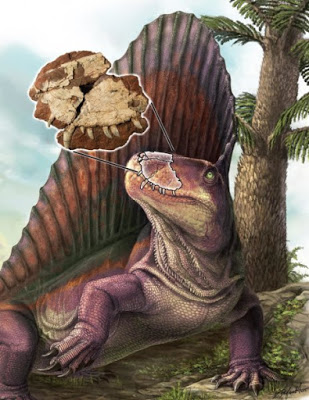
A “dinosaur” fossil originally discovered on Prince Edward Island has been shown to have steak knife-like teeth, and researchers from U of T Mississauga, Carleton University and the Royal Ontario Museum have changed its name to Dimetrodon borealis–marking the first occurrence of a Dimetrodon fossil in Canada.
“It’s really exciting to discover that the detailed anatomy of the teeth has finally allowed us to identify precisely this important Canadian fossil,” says lead author Kirstin Brink, who did the research while at UTM. “Dimetrodon is actually more closely related to mammals than it is to dinosaurs.” In fact, it’s believed they went extinct some 40 million years before the dinosaurs.
The study appears in the November 23 issue of the Canadian Journal of Earth Sciences.
The fossil, previously known at Bathygnathus borealis, was collected in 1845 while a farmer was digging out a well on his property near French River, PEI. As there were no natural history museums in Canada at the time the fossil was found, it was sold to the Academy of Natural Sciences in Philadelphia, where Joseph Leidy–a preeminent paleontologist–could study and name it.
Leidy named the fossil Bathygnathus (meaning deep jaw) borealis (from the north) because he mistook it as the lower jaw of a dinosaur, similar to the large bipedal species that were being collected in Europe at the time.
The Bathygnathus specimen was the first “dinosaur,” and the second vertebrate fossil named from Canada (Dendrerpeton, an extinct amphibian from Nova Scotia, was named by Sir Richard Owen two months earlier). Several paleontologists have studied the Bathygnathus specimen since it was first named, but its precise identity was unknown. For example, it was unclear whether it had Dimetrodon’s signature dorsal sail–created by tissue stretched between spines sticking up from its backbone–or lacked a sail like its smaller cousin Sphenacodon.
Using family trees and imaging techniques to see the internal anatomy of the fossil, researchers found that the eight preserved teeth linked the fossil to the Dimetrodon family–the first terrestrial animal to have “ziphodont” teeth.
“These are blade-like teeth with tiny serrations along the front and back of the teeth, similar to a steak knife,” says Professor Robert Reisz, the senior author of the study. “The roots of these teeth are very long, around double the length of the crowns. This type of tooth is very effective for biting and ripping flesh from prey.”
Fossils of Dimetrodon have now been found in the USA, Canada and Germany.
Reference:
Kirstin S. Brink, Hillary C. Maddin, David C. Evans, Robert R. Reisz, Hans-Dieter Sues. Re-evaluation of the historic Canadian fossilBathygnathus borealisfrom the Early Permian of Prince Edward Island. Canadian Journal of Earth Sciences, 2015; 1 DOI: 10.1139/cjes-2015-0100
Note: The above post is reprinted from materials provided by University of Toronto. The original item was written by Nicolle Wahl.










